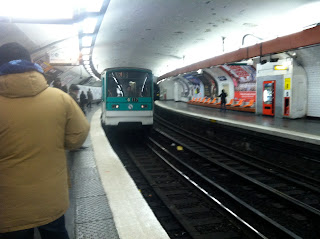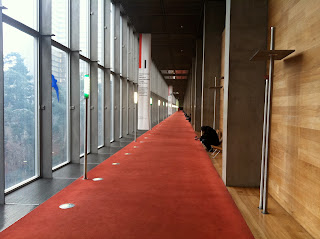My trip to the
Musee de Quai Branly last night left me with lots to wonder about, including this question about us as humans:
When do we seek to wear masks, and when do we seek to wear headdresses?
A mask is something that covers our identity. It hides the "I" behind the "this", and we become part of its identity.
 |
| There's something I'd rather you didn't see |
A headdress augments our identity and helps define our status in society and helps convey to others status that we hold or that we confer upon ourselves, or that has been conferred upon us.
 |
| There's something you should know about me |
We do both, of course, always. But it occurred to me that the headdress above is no different than the cloak below, though one is found in an ethnographic museum, and the other is found in St. Denis, a home to French kings, history and patrimony.
 |
| What was Louis XVIII trying to say? |
_______________
Review of Musee de Quai Branly
The Musee de Quai Branly is another piece of Paris magic. The building from the outside is an elegant piece of architecture courtesy of Jean Nouvel. It is famous for its "green wall", a vegetated structure that helps reduce its environment impact. Its location right on the Quai Branly interposes it between the river and some very expensive Paris apartments. It is perhaps a testament to the French that the possible opposition of some very rich people was not enough to stop a project that has broader cultural meaning.
Its tag line is "The place where cultures talk". This is a tricky business in fact. Understanding cultures without judgment is more challenging than perhaps it would first seem. This is made poignantly and painfully clear in a specific exhibit the museum has up now.
Entitled "
The Invention of the Savage", it examines the racist, destructive social construction of "savage" by Europeans over a time period beginning with Columbus' landing in the New World in 1492, through its apogee in late 19th century European colonialism, up to its final explicit manifestation in Belgium in 1958. This included displaying human being in zoo-like settings for the amusement and interest of the populations of Paris, London, Berlin and other European capitals around 1900.
Depressing though it is to see, the exhibit does a very good job of exploring and seeking to understand a phenomenon of atrocious consequences and implications - something we all know very well in its various manifestations. It does this without minimizing or ducking the very profound questions it raises about the European cultures (American culture not exempted either, sorry to say) that created, sanctioned and supported a set of attitudes we now find abhorrent and in some cases illegal.
Given the very righteous hackles raised in this well-constructed exhibit, it would make sense for the museum to show greater interest in its permanent exhibits too. Though beautifully displayed, they are almost impossible to decipher. Given that we are looking at ethnographic material, artifacts from cultures for which we have little to no reference points - information is key. The museum does a very poor job in my view, with very little in the way of logical sequencing of displays or of information.
This was not helped by the layout of the museum - a wandering maze of spaces and corridors. Feeling lost is rarely a good feeling, though sometimes it can be informative. I think the intention of the designers was to allow people to get lost in this space, but they got the balance wrong. I love getting lost in my wanderings around the city of Paris, but that is in part because I am always sure that I can locate myself and orient myself very quickly. Without that ability, the experience would be an unpleasant one. Well, true for the whole of Paris, also true for the interior of this museum. Way-finding tools are largely absent, which adds to the feeling that none of this information makes any sense.
But - and this is a very big "but" - I walk away from my evening there thinking heartily about what I saw, thoughts not easily dismissed, thoughts that work their way to some further future insight. Paris is insidious in this way. Consistently so.








































